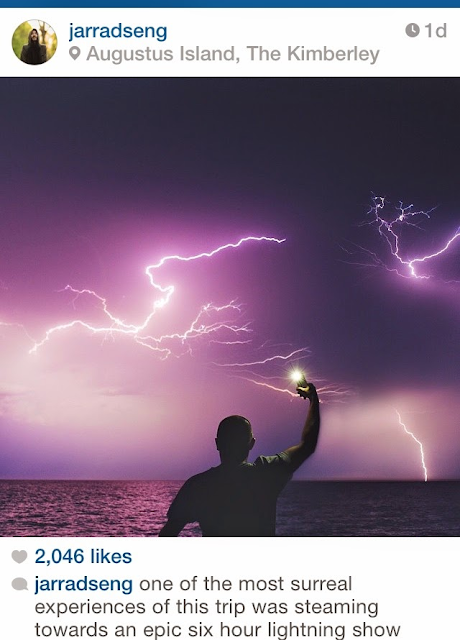Jerked rudely awake at 3am last night this morning by an almighty double thunderclap, which was disappointingly not followed by the consolation of a lightning show, I lay for several wakeful hours afterwards reflecting on nature's unexpected gifts. These have been the unplanned and unplannable, totally chance weather and/or wildlife events that have happily elevated what was already a fun travel experience into something properly special.
This morning's no-show lightning, for example, reminded me of the best display I've ever seen, or will ever see, that happened late one afternoon on a cruise along Western Australia's Kimberley coast. It was epic: six hours of non-stop forks, squiggles and flashes, as we gazed up from the deck first with our pre-dinner drinks, then eating dinner at sunset, then wallowing in the jacuzzi in the dark. No rain, no thunder, no sense of danger - just awe and amazement, and some personal frustration at not being able to capture the perfect shot. But we had Jarrad Seng on board, so that was ok.

It was in northern Australia too that I saw an immense cloud of fruit bats flying overhead at sunset, as I sat beside the artificial esplanade lagoon in Cairns, enjoying the sight of big silver fish sculptures against the coloured sky. They came in their thousands, from their roosts somewhere inland, streaming out over the town centre towards a headland across the bay where the mangoes were ripe. Apparently it's a nightly occurrence, but for me it was an unexpected and very memorable gift. Which I wish I had a photo of.
Again, in Australia (I have been there a lot for work), I was on a cattle drive through the Outback when, in the middle of the night, a dust storm swept through the camp. The walls of my tent billowed and shook, my ears popped, but I stayed hunkered down in my swag, tired enough from a day's riding after the cattle to get straight back to sleep. It was only when I emerged in the morning that I saw how lucky I'd been - several tents had been blown over, everything was covered in a film of fine red dust, and our cluster of tents was now cupped in the protective curve of the drive's big trucks, gallantly moved by staff during the storm to block the wind.
For travel writers, it's a gift when things go wrong on a famil, though they usually don't because we're being hosted by professionals. But nature doesn't respect that - so when I did the iconic 3-day Milford Track down in Fiordland, and it rained and rained on day 1, the guide was very apologetic. I didn't mind, even though at one point the track was flooded thigh-high with freezing water that we had to wade through. It was great material - and besides, the downpour stopped just before we had to be helicoptered onwards, and thereafter the weather was brilliantly sunny.
Running aground on an uncharted rock in a bay on a Rakiura Stewart Island cruise was a diversion, too. Yes, the scenery was gorgeous, our hike up to a viewpoint went ahead anyway, and the detour afterwards back to Oban for hull checks just gave us a different, and equally enjoyable, itinerary - but feeling the sudden shudder and stop, having to wait for the tide to float the ship off, and seeing scuba divers arrive to inspect underwater? Priceless.
Then there was the stowaway Cook Islands lizard that I discovered with horror, back home, had sneaked into my suitcase; the rhino that charged the van where I was sitting fully exposed alongside the open door in the back; the bear in Yosemite that suddenly appeared on the track eyeing me up speculatively. And finally, there was the glorious gift of Drake Lake - our two days of smooth glossy seas as we crossed the most rambunctious bit of ocean on the planet, on our return from Antarctica to Ushuaia. That was nature at her most generous and beneficent, and I will always be deeply grateful for the best trip I've ever been on not being ruined on the last bit.
UPDATE: As a bonus double connection today, when I went to browse Insta, what do I find but the latest post from super-photographer Daniel Kordan -


















.JPG)










